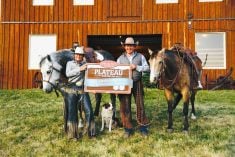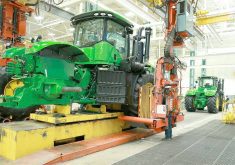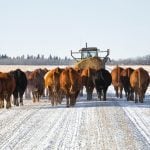Back in the early 1990s, when University of Manitoba animal scientist Laurie Connor first oversaw research into hoop-housing systems for hogs, the key questions of the day were whether keeping pigs outdoors through a Prairie winter threatened their welfare and/or compromised production efficiency.
Connor told a recent seminar she was initially mortified at the thought of keeping pigs in an outdoor facility through the cold winter months.
At the time, keeping sows in gestation stalls in heated barns was seen not only as more efficient, but more welfare friendly because the pregnant sows weren’t being attacked by their more dominant herdmates.
Read Also

Guarding against misinformation: Do you believe in house hippos?
Misinformation and disinformation run rampant in today’s digital age. Farmers must be wary of the digital dangers and know how to keep themselves safe.
True, sows weren’t allowed freedom of movement, but that was viewed as a reasonable compromise in exchange for the vast improvements in production efficiency. At the time, hoop housing and straw-based bedding were being explored as less capital-intensive alternatives. Animal welfare was a secondary concern.
The research found that although feeding costs were higher and different levels of management were needed, the system could match the productivity of conventional housing due to its lower capital costs.
After that, it sat on the shelf.
Now, scientists are tasked with finding ways to make various group-housing systems work economically — not as an alternative for producers seeking a lower-cost or niche-market option, but for conventional producers who could lose market access if they don’t transition out of gestation stalls.
This month fast-food giant McDonald’s served suppliers notice they are to come up with a plan for phasing out sow gestation stalls. Seven U.S. states have passed laws to end their use. Europe’s conversion is expected to be completed by 2013.
Thankfully, researchers have been able to refer back to those earlier studies and build on them in this current context.
Connor and many of her colleagues have over the course of their careers faced criticism from producers for acknowledging the downsides of gestation stalls. Likewise they have been accused of being an industry apologist for citing their benefits — evidence of their even-handed, science-based approach to the highly charged debate.
It is through these ongoing research efforts that our knowledge as it relates to sow behaviour and comfort has evolved. It is now acknowledged that pigs are inherently social beings and are more content when allowed to behave as a herd. The issues with aggression and dominance can be managed with individual feeding.
The sight of a sow chewing on stall bars or excessively drinking water was once seen as a sign of agitation due to boredom; it is now believed related to hunger — a factor of a nutrient-dense feed ration that isn’t very filling. That can be mitigated by providing straw or other forms of fibre.
So we know we can make group housing work for the sows. Whether it can work for farmers is based on a number of variables ranging from the cost of renovating, to their ability to adapt their herd and nutrient management.
What’s interesting and laudable about this unfolding story is the absolute importance of science to increase understanding of complex issues. Back in the 1990s, scientists were asking questions the mainstream industry considered irrelevant. Thank goodness.















